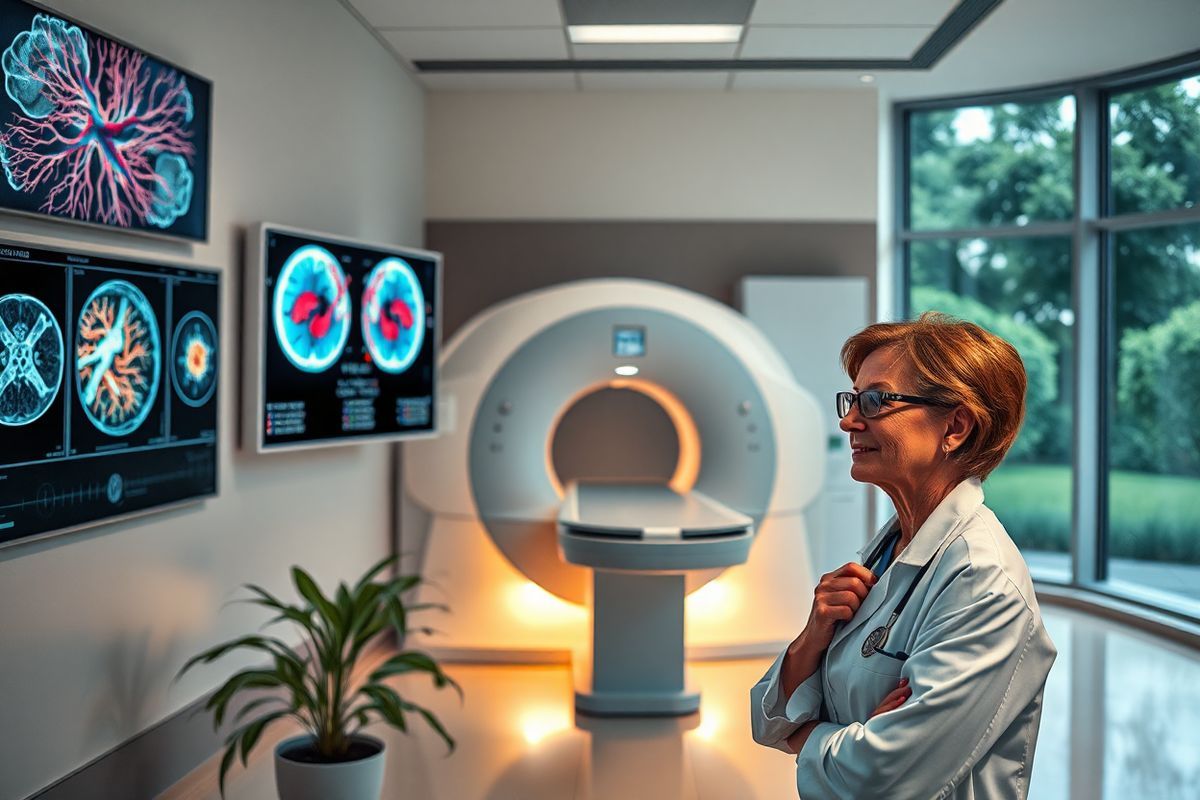Table of Contents
Understanding Hereditary Hemorrhagic Telangiectasia (HHT) and Its Implications

Hereditary Hemorrhagic Telangiectasia (HHT), also known as Osler-Weber-Rendu syndrome, is a rare genetic disorder characterized by the formation of abnormal blood vessels, leading to various complications. The condition is caused by mutations in genes that encode proteins responsible for blood vessel formation and maintenance. The most commonly affected genes are ENG (endoglin) and ACVRL1 (activin receptor-like kinase 1), which play crucial roles in the vascular system (Cleveland Clinic, 2023). HHT affects approximately 1 in 5,000 individuals worldwide, equally impacting all genders and ethnicities.
Symptoms often manifest during childhood or adolescence and can include frequent nosebleeds, telangiectasias (small dilated blood vessels), and arteriovenous malformations (AVMs) in various organs such as the lungs, liver, and brain. These vascular anomalies can lead to serious health issues including significant blood loss, anemia, and organ damage, requiring timely diagnosis and management (Mayo Clinic, 2023).
Despite its significant health implications, HHT remains underdiagnosed. Misdiagnosis is common, as symptoms often resemble those of more prevalent conditions, leading to delayed treatment in many individuals. This delay can have dire consequences, such as life-threatening hemorrhages or complications from organ involvement (NHS, 2023).
The Essential Role of Medical Imaging in HHT Diagnosis
Medical imaging plays a pivotal role in the diagnosis and management of HHT, allowing for the visualization of vascular abnormalities that are not apparent through physical examination alone. Several imaging modalities are utilized to assess the presence and severity of AVMs and telangiectasias, including:
-
Magnetic Resonance Imaging (MRI): MRI is particularly effective in visualizing brain AVMs, which can be life-threatening if ruptured. It offers excellent soft tissue contrast and can help identify subtle changes in vascular structures.
-
Computed Tomography (CT): CT scans are crucial for detecting pulmonary AVMs and assessing the extent of bleeding in cases of suspected hemorrhage. CT angiography can provide detailed images of blood vessels.
-
Ultrasound: This non-invasive technique is often used to evaluate liver AVMs or other vascular malformations. It is particularly useful in pediatric patients due to its safety and ease of use.
-
Digital Subtraction Angiography (DSA): DSA is the gold standard for visualizing vascular structures. It is often used in interventional procedures to treat AVMs via embolization, where materials are injected to block the abnormal blood vessels (FDA, 2023).
The choice of imaging modality may depend on the specific symptoms and the clinical scenario presented by the patient. The integration of imaging findings with clinical symptoms is vital for accurate diagnosis and effective management.
Advancements in Radiology Techniques for Accurate HHT Detection

Recent advancements in radiology have significantly improved the detection and characterization of HHT-related vascular abnormalities. Innovations such as high-resolution imaging techniques, 3D reconstructions, and advanced post-processing software have enhanced the ability of radiologists to identify and assess vascular lesions accurately.
-
High-Resolution Imaging: High-resolution CT and MRI techniques enable detailed visualization of small vascular structures, improving the detection of AVMs and telangiectasias. These advancements are particularly beneficial in evaluating brain and pulmonary complications associated with HHT.
-
3D Reconstruction: Advanced imaging software allows for the 3D reconstruction of vascular structures, providing clinicians with a comprehensive view of the extent and complexity of vascular malformations. This is crucial for planning interventional procedures.
-
Fusion Imaging: Combining different imaging modalities, such as PET/CT or MRI/CT, can provide complementary information, enhancing diagnostic accuracy. For example, PET imaging can help assess the metabolic activity of AVMs, while CT provides anatomical detail.
-
Machine Learning and AI: The integration of artificial intelligence in imaging analysis is poised to revolutionize the diagnosis of HHT by facilitating the automated detection of vascular abnormalities. Machine learning algorithms can be trained to recognize patterns consistent with HHT, potentially improving diagnostic efficiency and accuracy (Queiro-Palou et al., 2024).
These advancements underscore the importance of radiology in the multidisciplinary approach to managing HHT, from diagnosis to treatment planning.
Navigating the Challenges of Diagnosing HHT Through Imaging
Despite the available imaging techniques, several challenges persist in the diagnosis of HHT. These challenges can lead to delays in referral and treatment:
-
Variability in Symptoms: The diverse presentation of symptoms in HHT can complicate the diagnostic process. Patients may exhibit a range of symptoms that overlap with other, more common conditions, leading to misdiagnosis.
-
Inconsistent Imaging Findings: The presence and extent of vascular malformations can vary significantly between patients, making it difficult to establish a standard diagnostic protocol. Some patients may present with minimal symptoms but have significant vascular involvement that requires intervention.
-
Access to Advanced Imaging: In some regions, access to advanced imaging technologies may be limited, resulting in reliance on less sensitive modalities that may overlook subtle vascular abnormalities.
-
Need for Multidisciplinary Collaboration: Effective management of HHT requires collaboration among various specialties, including radiologists, geneticists, and vascular surgeons. This collaborative approach can be challenging to implement in practice, particularly in less specialized healthcare settings.
Addressing these challenges requires a concerted effort to raise awareness of HHT among healthcare providers, improve access to imaging technologies, and foster multidisciplinary collaboration.
Future Perspectives: Enhancing Radiological Approaches for HHT Management
The future of HHT management through medical imaging looks promising, with several emerging trends and technologies set to enhance diagnostic capabilities and treatment outcomes:
-
Telemedicine: The rise of telemedicine offers the potential for remote consultations and imaging assessments, particularly beneficial in rural or underserved areas. This could facilitate timely diagnosis and management of HHT.
-
Personalized Imaging Protocols: Tailoring imaging protocols based on individual patient risk factors and symptom profiles could enhance diagnostic accuracy. This personalized approach may involve leveraging artificial intelligence for optimal imaging selection.
-
Research and Clinical Trials: Ongoing research into the genetic basis of HHT and the role of imaging in monitoring disease progression is crucial. Clinical trials assessing new imaging techniques and treatment modalities will inform best practices in managing HHT.
-
Public Awareness Campaigns: Increasing awareness of HHT among both healthcare professionals and the general public can lead to earlier diagnosis and intervention. Educational initiatives aimed at recognizing the signs and symptoms of HHT could significantly impact patient outcomes.
In conclusion, medical imaging is an indispensable tool in the diagnosis and management of HHT. Continued advancements in imaging technologies and collaborative efforts among healthcare providers will enhance the ability to detect and treat this complex condition effectively.
FAQ
1. What is the primary cause of HHT? HHT is primarily caused by genetic mutations, most commonly in the ENG and ACVRL1 genes, which affect blood vessel formation and maintenance.
2. How is HHT diagnosed? Diagnosis is typically based on clinical symptoms and imaging studies that reveal the presence of AVMs and telangiectasias. Genetic testing can also confirm a diagnosis.
3. What imaging techniques are commonly used for HHT? Common imaging techniques include MRI, CT scans, ultrasound, and digital subtraction angiography (DSA).
4. What are the potential complications of HHT? Complications can include severe bleeding, anemia, organ damage, and increased risk of stroke, particularly from brain AVMs.
5. Is there a cure for HHT? There is currently no cure for HHT, but treatment focuses on managing symptoms and complications, particularly through interventional radiology for AVMs.
References
- Cleveland Clinic. (2023). Hereditary hemorrhagic telangiectasia - Symptoms and causes. Retrieved from https://my.clevelandclinic.org/health/diseases/15618-hereditary-hemorrhagic-telangiectasia-hht
- Mayo Clinic. (2023). Hereditary hemorrhagic telangiectasia - Symptoms and causes. Retrieved from https://www.mayoclinic.org/diseases-conditions/hht/symptoms-causes/syc-20351135
- NHS. (2023). Hereditary haemorrhagic telangiectasia (HHT). Retrieved from https://www.nhs.uk/conditions/hereditary-haemorrahagic-telangiectasia/
- FDA. (2023). Medical imaging
- Queiro-Palou, A., Jin, Y., & Jakobsson, L. (2024). Genetic and pharmacological targeting of mTORC1 in mouse models of arteriovenous malformation expose non-cell autonomous signalling in HHT. Retrieved from https://doi.org/10.1007/s10456-024-09961-5



